Yunnan is an ideal place to spend your holidays as it has pleasant climate throughout the year, plus the spectacular natural scenery, and a variety of minority cultures. If you are visiting Yunnan for the first time, this 7 days Lijiang Shangrila and Kunming tour is an great choice. What to expect on this 7 days Yunnan tour: *See the used-to-be trading place of the Tea Horse Ancient Road (the Silk Road in Southwest China), Lijiang Ancient Town. *Discover the mystery of Naxi culture in Baisha Village. *Ascend the biggest snow mountain in the Northern Hemisphere-Jade Dragon Snow Mountain. *Immerse in the Karst landscape of the Stone Forest.

After you arrive at Lijiang Sanyi International Airport, your tour guide will pick you up and transfer you to the hotel. On the way to the hotel, your professional guide will introduce to you the attractions that you are going to visit. After a moment of rest at the hotel, you will start your 7-day journey “Meet the Beauty of Yunnan”.
Lijiang served as a hub to connect Yunnan, Sichuan, and Tibet in ancient times. Taking the advantage of its geographical location, Lijiang developed into a major market where frequent businesses and trade activities were promoted and also a major city for people to settle down.
Our first destination is the Lijiang Ancient Town. With a long history and picturesque scenery, Lijiang is the hometown of the Naxi ethnic minority group, the descendants of the ancient Qiang people. As one of China’s well-known historical and cultural cities and the nation’s famous attractions, Lijiang Ancient Town attracts visitors from home and abroad.
Lijiang Ancient Town is the central city of Lijiang Naxi Autonomous County. It is estimated that Lijiang Ancient Town was established during the early Yuan Dynasty (1206 - 1368) because Kublai Khan, the first emperor of the Yuan Dynasty, had settled his troops in Lijiang Ancient Town on the way of marching to Dali with his army in 1253.
Lijiang was once governed by the chieftain of the Naxi tribe. Until 1382, after claiming their allegiance to the central government of the Ming Dynasty (1368 - 1644), Ajia and Ade, the actual rulers of Lijiang were granted the surname “Mu (木)” by Zhu Yuangzhang, the first emperor of the Ming Dynasty and entitled “Tusi (a title especially for the ruler in the southwest frontier region by the central government during the Yuan, Ming, and Qing Dynasties in China)”. Since then, Lijiang was governed by the chieftain of the Mu clan under the jurisdiction of the central government for hundreds of years.
Different from any other ancient city in China, Lijiang Ancient Town has no city wall surrounded. This is because the rulers were granted the surname “Mu (木)”, and they believed that if a city wall (like the Chinese character “口”) was built, it will form a Chinese character “困” that means trapped. It is not ill-boding. Therefore, building city walls here remains something of a taboo.
You can never miss Mufu, the residence of the ruler. It imitates the layout of the Forbidden City and absorbs the unique Naxi architectural styles. You can also visit Sifang Street Square, the central square of the town, which covers an area of 4,000 square meters. It served as a market for trade and business in ancient times. “Sifang” in Chinese means “everywhere”. The “Sifang Street Square” was named by Tusi that intended to express the meaning of the dominion of the Mu clan was everywhere.
Walking along the clean, time-horned roads, Lijiang Ancient Town will feed your eyes with those antique wooden-structured folk households, stone bridges, trees and flowers.
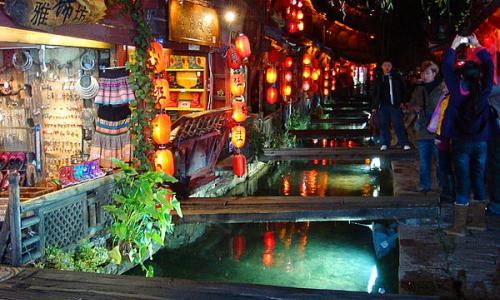

This morning we will visit the Jade Dragon Snow Mountain. It is located about 20 KM north of Lijiang (a 50-minute drive). With white snow on its top all year round, the fan-shaped mountain range extends about 75 KM. There are thirteen peaks arranged longitudinally from south to north. The highest peak is 5,596 meters above sea level, and the height of the snow line is between 4,800 and 5,000 meters.
The name of Jade Dragon Snow Mountain means “Holy Mountain” in the Naxi folk language. Legend has it that the Jade Snow Mountain is the incarnation of the Naxi guardian god Sanduo. We will visit the mountain by cableway. There are three routes for visitors to choose from: Jade Dragon Snow Mountain Big Cable Car, Spruce Meadow Cable Car, and Yak Meadow Cable Car. The three different cables will take you to three different destinations and you can experience different sceneries. You will take the Spruce Meadow Cable Car. When you arrive, you will visit a huge meadow hidden in the original spruce forest and experience the tranquility of the primeval forest. (Notice: The cable service may be canceled due to bad weather conditions.)
After coming down from the mountain, you will visit Blue Moon Valley. It is famous for the crescent-shaped lake that is located at a valley of the Jade Dragon Snow Mountain. During the sunny days, the water of the lake is blue while during the rainy days the water turns white. Therefore, it is also call Baishui River which means the river with white water in Chinese.
After lunch, we will drive to the Baisha Village which is located about 24 KM south of Jade Dragon Snow Mountain (30-minute drive). The village is known for the Baisha Mural Paintings -- an important part of the World Cultural Heritage in Lijiang. The Baisha Mural Paintings involve a wide range of subjects, depicting natural scenes such as running horses, blooming lotuses, mountains, forests, fields, birds, and insects. At the same time, those paintings are integrated with religious culture and show the civil life of the time. Dabaoji Palace houses the most precious and well-preserved mural paintings painted more than 300 years ago.
Our last traveling destination for today is Shuhe Ancient Town. It was once the distribution center of the Lijiang fur trade and one of the hubs of the Ancient Tea Horse Road (the ancient trade road of southwest China). You will be suggested to visit Qinglong Bridge, Longquan Temple, and Dajue Palace here.
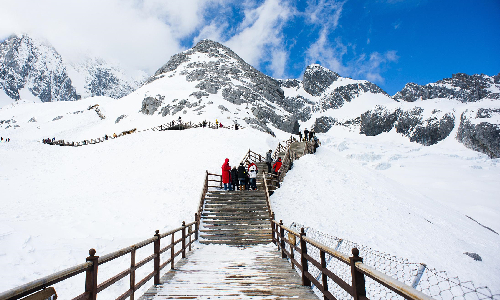
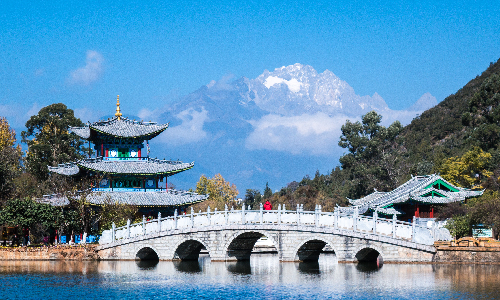
 Shangri-La
Shangri-La This morning, we will head to our next destination -- Shangri-La, the lost paradise in Yunnan. Shangri-La is located about 170 KM north of Lijiang (a 3-hour drive).
You will never get bored by such a long journey because you will also visit some places along the way to Shangri-La, such as the First Bend of the Yangtze River and the Tiger Leaping Gorge.
After around an hour of driving, you will arrive at the First Bend of the Yangtze River. The Yangtze River rushes down from the “Roof of the World” -- the Qinghai-Tibet Plateau into Yunnan Province, together with the Lancang River and the Nu River, forming a magnificent landscape of “Three Parallel Rivers of Yunnan Protected Areas”. After entering Shasongbi Village in Shangri-La County, the Yangtze River suddenly turns more than 100 degrees to the northeast, forming a rare V-shaped bend. Therefore, this wonder is called “the First Bend of the Yangtze River”. You will have a good view of this V-shaped bend at Shigu Village.
Then, we will drive another 50 KM (90 minutes) to take you to the Tiger Leaping Gorge. The gorge is with the Jade Dragon Snow Mountain on its east and the Haba Snow Mountain of Shangri-La County on its west. Full of swift-flowing rivers, and numerous reefs, this gorge is 17 KM long and is divided into three parts respectively — Shanghutiao (the upper part), Zhonghutiao (the middle part), and Xiahutiao (the lower part). With a vertical height difference of more than 3,900 meters, the Tiger Leaping Gorge is one of the world’s deepest gorges. Shanghutiao is the narrowest part of the gorge where a huge stone erects in the middle of the river and divides the current into two. As a legend had it, a vigorous tiger leaped from the Jade Dragon Snow Mountainside to the Haba Snow Mountainside with the huge stone as a foothold. Therefore, the stone is named “Tiger Leaping Stone” while the gorge is named “Tiger Leaping Gorge”. Xiahutiao, with a one-kilometer-deep valley, provides the best sightseeing place.
And then, we will arrive in Shangari-La. The name Shangri-La means “the moon and the sun in people’s heart”. With a unique geographical location, Shangri-La is endowed with picturesque landscapes and abundant natural resources. You will see lofty snow mountains, running rivers, primeval forests, and alpine meadow decorated with diamond-shaped lakes and tiny wildflowers here.
Shangri-La embraces a lot of diversities except for natural landscapes. It is also known for its diverse folk culture. About 25 indigenous minority ethnic groups, such as Tibetan, Naxi, Han, Lisu, Yi, Bai, Miao, Hui, and Pumi people inhabit here. Also, different religions coexist here, such as Tibetan Buddhism, Dongbaism, Christianity, Islam, Taoism, and other religions. Hundred years of cultural exchanges and integrations have bred unique ancient ethnic cultures, such as festivals, folk costumes, local food, architecture styles, as well as literature and art. Shangri-La has become such a county where multi-ethnic groups live together, with multi-religious coexistence and multi-cultural co-prosperity.
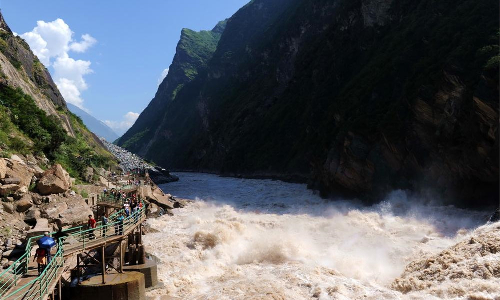
This morning we will visit Songzanlin Monastery. It is located about 5 KM north of the city center (a 10-minute drive).
Songzanlin Monastery is named by the fifth Dalai Lama and it is also known as Guihua Monastery. known as the “Art Museum of Tibetan Buddhism”, this is the largest Tibetan Buddhist monastery in Yunnan Province. Its construction started in 1679 and was completed in 1681.
Since it is quite similar to the Potala Palace in Lhasa, the monastery has the reputation of “Little Potala Palace”. The monastery is not only known for its exquisite architectural style but also for many religious artifacts and precious cultural relics. The most valuable among them are eight gold-clad Buddha statues of Sakyamuni, Sarada palm-leaves scripture, and ten volumes of Tengyur Canon.
The monastery consists of three main halls that are to enshrine Buddhas and eight side halls that are used for lamas to learn the Buddhist doctrine. The three main halls are decorated with golden roofs, which are magnificent and splendid. The middle hall is the five-story Zhacang Hall (also known as Fa Hall) where the fifth Dalai Lama is enshrined. When you enter the hall, you will see that the two walls of the hall serve as cabinets that house precious Tibetan scripture. Buddha statue of Master Tsongkhapa, the founder of the Gerug Sect of Tibetan Buddhism is enshrined in the left hall. And the golden statue of Sakyamuni is enshrined in the right hall with exquisite Buddhist murals on the walls.
After lunch, we will drive for 40 minutes to the Pudacuo National Park. Pudacuo National Park is located in the center of the “Three Parallel Rivers” World Natural Heritage in northwestern Yunnan province, 25 KM away from Shangri-La County, with a total area of about 300 square kilometers. The park is the first national park on the Chinese mainland. It integrates the functions of environmental protection, ecological and cultural tourism, and environmental education. The tourism resources of the park include natural ecological landscapes and cultural resources. You will see unique landforms including lakes and wetlands, forests and meadows, river valleys and streams. You will also encounter rare animals such as black-necked crane and macaque. At the same time, you can also experience traditional Tibetan culture, including religious culture, farming and pastoral culture, and folk customs.
To better experience the traditional Tibetan culture, you will be invited to visit a local Tibetan family. The hospitable Tibetan host will prepare butter tea for you and you can have free talks with the family to better understand their culture and life.
Tips:
1. Shangri-La has a dry climate and strong ultraviolet radiation. You need to prepare sunscreen, a sun hat, and sunglasses. From June to September each year it is the rainy season, and you need to bring rain gear and anti-slip boots. The winter days are chilly. Therefore, if you travel after October, you are suggested to bring warm clothes, such as down jackets and gloves.
2. Photography enthusiasts can bring a few plastic bags (or shower caps) to cover the equipment for protection on rainy days.
3. Shangri-La is located in a high-altitude area (3,300 meters). To prevent altitude sickness, it is not suitable for strenuous exercise or alcohol drinking. If you get sickness, please inform the tour guide immediately.
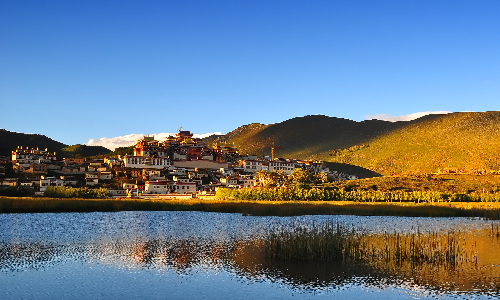
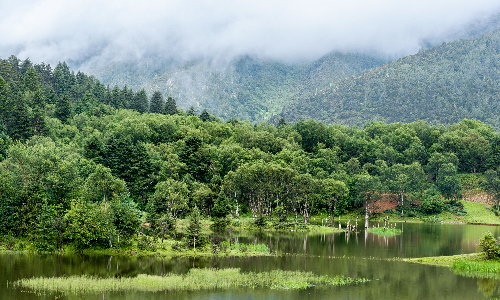
 Kunming
Kunming This morning you will fly back to Kunming to spend the last two days of your journey. After breakfast and check-out, you will be sent to the airport and take the estimated flight MU5932 8:50/10:05 to Kunming. We will arrange a bus to pick you up at the airport.
After lunch, you will visit the Western Hills Forest Park. It is located in the western suburbs of Kunming. Overlooking the peaks of the Western Hills, you may feel that it is like a “sleeping beauty” lying beside Dianchi Lake. The park is mainly composed of scenic spots such as the Huating Temple, Taihua Temple, Sanqing Pavilion, and Dragon Gate. The Huating Temple, founded in the 14th century, is located in the mountains at an altitude of 2,050 meters. The temple is a famous Buddhist holy land in Kunming. The Taihua Temple, built at the beginning of the 14th century, serves as the best place to watch the sunrise and sunset of Dianchi Lake. Sanqing Pavilion and Dragon Gate are a group of buildings built on the cliffs of Luohan Mountain, the main peak of West Hills. Climbing to the Dragon Gate, leaning on the railing, and looking down, you will see the cliffs, the lush forests, and the panoramic view of Dianchi Lake.
After the visit, you may feel tired and we will arrange a bus to transfer you to the hotel.
Option Activity:
Kunming’s nightlife is colorful. You can go to bars and cafes nearby for leisure and entertainment.
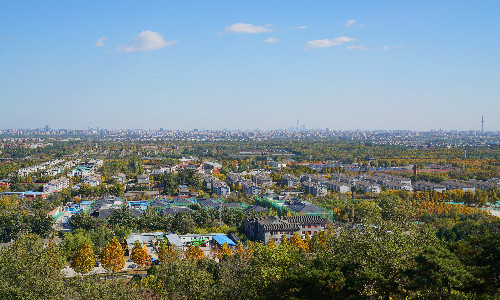
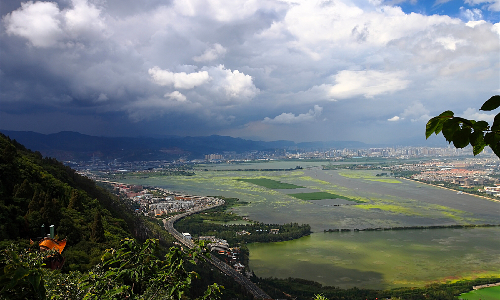
This morning we will guide you to visit the Stone Forest. The Stone Forest is located in Shilin Yi Autonomous County, 80 KM away from Kunming (70-minute drive). There are around 1,100 square kilometers of karst geological landscape in Shilin County. There are various types of stones with high aesthetic values in the Stone Forest. Therefore, it enjoys the reputation of “the essence of karst world” and “the natural geomorphology museum”. As an important part of the “Southern China karst landscape”, this scenic spot was successfully included in the “World Natural Heritage” list in 2007.
Strolling in the Stone Forest, you will find sword-shaped, columnar, tower-shaped, mushroom-shaped, and irregular stones and be amazed by the wonders of nature.
After visiting the Stone Forest, you will go back to Kunming and have lunch. In the afternoon, you will visit the Yuantong Temple. This temple, located on Yuantong Street, is one of the oldest and the largest Buddhist temples in Kunming. It has a history of more than 1,200 years which can be dated back to the Tang Dynasty (618 - 907). Then, you will visit Cuihu Park where you may see flocks of seagulls flying in the sky and you can feed them with breadcrumbs.
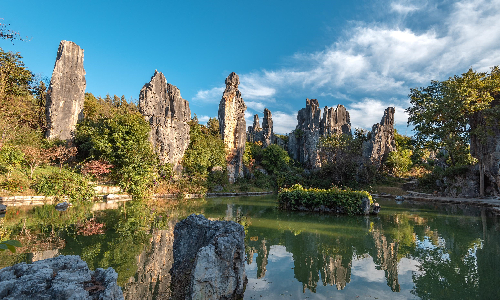
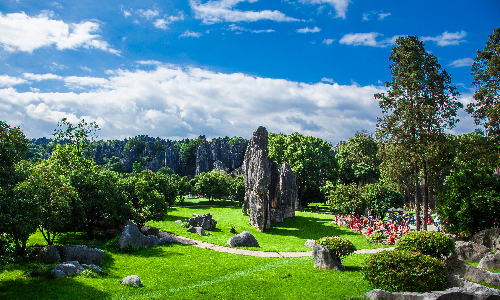
Your 7-day journey will come to an end today. After breakfast, you will head for Kunming Changshui International Airport and our tour guide will arrange a bus for you based on your time of flight. China Tour Star Tourist Agency hopes that you enjoy your staying here and the 7-day journey will be an unforgettable memory for you. We are looking forward to your next visit with your family and friends!
Editor: Jingwen Wu
Proofreader: Betsy He
| City | Five Star hotel list | Four Star hotel list |
|---|---|---|
| Lijiang | Wonderport International Hotel | Lijiang Wangfu Hotel |
| Shangri-La | Paradise Hotel | Ri Yue Xing Cheng Hotel |
| Kunming | Grand Park Kunming | UChoice Hotel |
 |
![]() About your child or infant, please contact us for a discounted price.
About your child or infant, please contact us for a discounted price.



We started with a few days in Beijing & ended in Shanghai, from where we visited the Forbidden City and Great Wall. In between we visited Terra Cotta Warriors Museum, Panda Base, Shanghai Disneyland.

We had a wonderful holiday in China which will remain long in the memory. China is a breathtakingly beautiful country full of splendid temples and palaces, mountains and rivers, peaceful rural scenes and bustling shopping streets.
 QUICK ENQUIRY
QUICK ENQUIRY